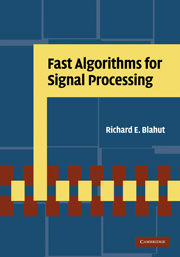Book contents
- Frontmatter
- Contents
- Preface
- Acknowledgments
- 1 Introduction
- 2 Introduction to abstract algebra
- 3 Fast algorithms for the discrete Fourier transform
- 4 Fast algorithms based on doubling strategies
- 5 Fast algorithms for short convolutions
- 6 Architecture of filters and transforms
- 7 Fast algorithms for solving Toeplitz systems
- 8 Fast algorithms for trellis search
- 9 Numbers and fields
- 10 Computation in finite fields and rings
- 11 Fast algorithms and multidimensional convolutions
- 12 Fast algorithms and multidimensional transforms
- A A collection of cyclic convolution algorithms
- B A collection of Winograd small FFT algorithms
- Bibliography
- Index
6 - Architecture of filters and transforms
Published online by Cambridge University Press: 03 May 2011
- Frontmatter
- Contents
- Preface
- Acknowledgments
- 1 Introduction
- 2 Introduction to abstract algebra
- 3 Fast algorithms for the discrete Fourier transform
- 4 Fast algorithms based on doubling strategies
- 5 Fast algorithms for short convolutions
- 6 Architecture of filters and transforms
- 7 Fast algorithms for solving Toeplitz systems
- 8 Fast algorithms for trellis search
- 9 Numbers and fields
- 10 Computation in finite fields and rings
- 11 Fast algorithms and multidimensional convolutions
- 12 Fast algorithms and multidimensional transforms
- A A collection of cyclic convolution algorithms
- B A collection of Winograd small FFT algorithms
- Bibliography
- Index
Summary
Now that we have a large collection of algorithms for convolutions and for the discrete Fourier transform, it is time to turn to how these algorithms are used in applications of signal processing. Our major purpose in this chapter is to discuss the role of algorithms in constructing digital filters. We shall also study other tasks such as interpolation and decimation. By using the methods of nesting and concatenation, we will build large signal-processing structures out of small pieces. The fast algorithms for short convolutions that were studied in Chapter 5 will be used to construct small filter segments.
The most important device in signal processing is the finite-impulse-response filter. An incoming stream of discrete data samples enters the filter, and a stream of discrete samples leaves. The streams of samples at the input and output are very long; in some instances millions of samples per second pass through the filter. Fast algorithms for filter sections always break the input stream into batches of perhaps a few hundred samples. One batch at a time is processed. The input samples are clocked into an input buffer, then processed one block at a time after that input block has been completed. The resulting block is placed into an output buffer, and the samples are clocked out of the output buffer at the desired rate.
Convolution by sections
Many algorithms for the discrete Fourier transform were studied in Chapter 3.
- Type
- Chapter
- Information
- Fast Algorithms for Signal Processing , pp. 194 - 230Publisher: Cambridge University PressPrint publication year: 2010



